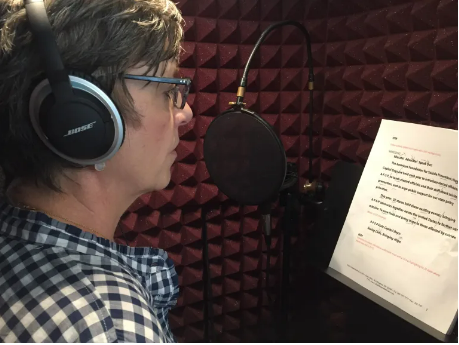Learning Objectives
- Vocal Delivery Tips {audio & video examples}
- Script Marking for Vocal Inflection
- Warm Up Exercises Before Voicing


Most people don’t love the sound of their own recorded voice.
Recordings often seem higher-pitched or thinner than what we think we sound like. That’s because we hear ourselves in two ways: through sound waves in the air and through internal vibrations traveling through the bones of the skull. Those internal vibrations create a richer, lower tone—one no microphone ever captures.

The good news: you can strengthen and improve your vocal delivery. Start with abdominal diaphragmatic breathing—“belly breathing”—which helps you draw air deeper into the lungs for a fuller, more controlled voice.
Standing while recording can also expand your breathing capacity and reduce abdominal compression.
Even more important than voice tone is voice style. This chapter walks through relaxation techniques, vocal warm-ups, and script marking tools to help you sound natural, confident, and conversational. You don’t need broadcaster-style “golden pipes.” Speech clarity, pacing, and inflection matter far more.
Do warm-up exercises to pump blood into tissues to stretch and relax the muscles by getting them to work more efficiently. Vocal warmups help prevent injury to your delicate vocal cords.
They also help you center yourself mentally before an interview, speech, or podcast taping. They may seem simple, but with consistent practice they build agility and confidence.

Basic Warm-Up Sequence
1) Warm-up our lips by opening the mouth vertically and saying “bah” “bah” “bah.”
2) Now switch to lips air-buzzing with Brrrrrrr ….. Brrrrrr …… Brrrrrr …..
3) Open up your mouth vertically and say an exaggerated “Lah, Lah, Lah, Lah” and sing up in pitch and/or down in pitch.
4) Trill your tongue by rolling with an Rrrrrrrrr.
5) Now say or sing the phrase Mah-May-Me-Mo-Moo.
6) Do a pitch change by counting to three and going up in pitch with each number; one-two-three; then go down in pitch and say three-two-one.
7) End with a familiar nursery rhyme tongue twister:
Peter Piper picked a peck of pickled peppers.
Did Peter Piper pick a peck of pickled peppers?
If Peter Piper picked a peck of pickled peppers,
Where’s the peck of pickled peppers Peter Piper picked?
WATCH the video & then follow along as you do 5-minute vocal warmups.
Warm-Up Exercises
Vocal Exercises
Pitch Awareness
Articulation
Tongue Teasers
In a fun, interactive video NPR announcer Jessica Hansen offers three tips for training your voice.
Before recording, read your script aloud to spot where you should pause, breathe, or emphasize key phrases.
• Indicate pauses with ellipses (…) or slashes (/).
• Mark emphasis by underlining, italicizing, or using ALL CAPS.
• Use ↑ or ↓ arrows to note pitch shifts—typically rising at questions and falling at statements.

Public-speaking anxiety is incredibly common.
Mentally prepare for voice work by doing the “countdown to calm down”: say “Five, four, three,” then silently count to zero. By zero, your voice should settle into its natural pitch rather than launching too high from nerves.

We naturally vary our inflection when talking with friends, yet many people flatten their delivery when a microphone appears. Use your voice to convey emotion—joy, concern, excitement—without editorializing, especially in journalism-based podcasts. Keep it authentic and conversational.
Reading your script aloud as you write can also create a more natural flow.

Slow down slightly when speaking on mic. Without visual cues, listeners depend entirely on your pacing. Speaking too quickly can cause dropped syllables and muddled articulation. Clarity always wins..

If your pitch goes up at the end of every sentence, it’s called “valley-girl speak” or “uptalking.”
The other irritating speech pattern to avoid is “vocal fry,” a low growl sound at the end of a sentence. Some people blame the phenomenon on Kim Kardashian and those who want to imitate her. CBS News Sunday Morning contributor Faith Salie explains the phenomenon with a fun tongue-in-cheek look at creaky young women.

Try to be your authentic self rather than a carbon copy of someone else. You want to be conversational and avoid stilted language to establish rapport with your guest and audience.
But remember that you are hosting a show for others so you need to be energetic and to have excitement in your voice rather than sounding flat.
Beyond that, keep a consistent speaking level rather than being up-and-down with volume levels that are too loud or too soft.

When speaking into a microphone, there’s sometimes a strong breath of air that seems to explode into the microphone. These plosives are worse on words with p’s and b’s.
Tips to reduce plosives:
Angle the microphone to the side of your mouth rather than speaking directly into it.

For more mic-handling guidance, see advice from the podcast hosting company Buzzsprout.
Many people develop an unconscious pattern of letting their voice trail off at the end of a sentence, almost like they have run out of energy. Stay focused and avoid long, meandering monologues that drain momentum.


